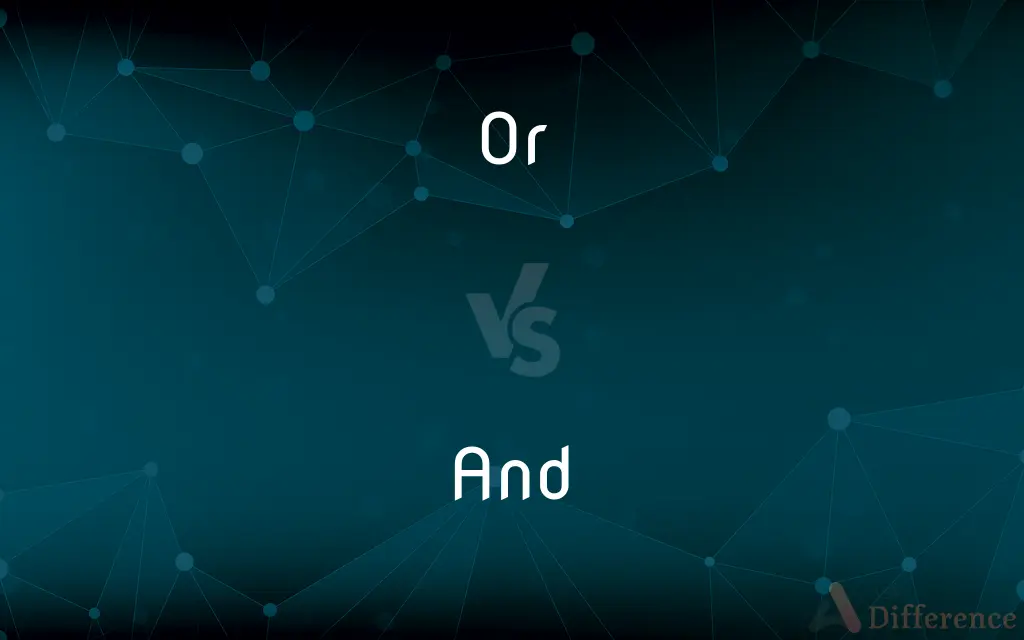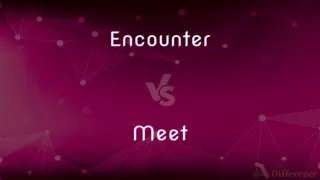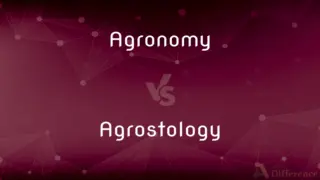Or vs. And — What's the Difference?
By Urooj Arif & Maham Liaqat — Updated on March 21, 2024
Or signifies a choice between alternatives, whereas And connects items in addition.

Difference Between Or and And
Table of Contents
ADVERTISEMENT
Key Differences
Or is used to indicate options or alternatives, suggesting that only one among the presented choices may be true or applicable. For example, in the sentence "You can have tea or coffee," the use of "or" presents two options, implying that the listener can choose one but not both. And, on the other hand, is used to connect words, phrases, or clauses that are related and often implies that both or all connected elements are included or considered together. For example, in "She bought apples and oranges," "and" combines two items, suggesting that both were purchased.
Or often presents a choice that excludes, meaning if one option is true or chosen, the others are not. This is seen in statements like "Would you prefer to go by car or by train?" implying that only one mode of transportation can be selected. And, in contrast, implies inclusivity and accumulation, as seen in instructions like "Please bring your ID and a pen to the exam," where both items are required. It doesn't suggest a choice but rather a combination of elements.
Or can introduce an alternative in the context of uncertainty or possibilities, particularly in questions or hypothetical situations. For example, "Are you going to the party, or will you stay home?" explores two possible actions, leaving open which might occur. And is also used to indicate a sequence or a series, linking items in a list or steps in a process, as in "First, preheat the oven, and then mix the ingredients," where it shows progression and connection between actions.
Comparison Chart
Basic Function
Presents alternatives or choices.
Connects items or ideas, indicating addition.
Context of Use
Used when indicating options where typically only one is possible.
Used when combining items that are all considered together.
ADVERTISEMENT
Implication
Implies exclusivity or a need to choose between presented options.
Implies inclusivity and the coexistence of all connected items.
Type of Connection
Connects mutually exclusive alternatives.
Connects complementary or related elements.
Example Usage
"Do you want coffee or tea?" - Implies you should choose one.
"She enjoys reading and writing." - Suggests she likes both activities.
Compare with Definitions
Or
Used to link alternatives or choices.
Would you prefer tea or coffee?
And
Connects similar ideas, items, or clauses.
She bought apples and oranges from the market.
Or
Used in either/or structures to present two possibilities.
Either you leave now or stay till the end.
And
Indicates a sequence or addition.
First, gather your materials, and then begin the project.
Or
Introduces a synonymous or explanatory term.
The feline, or cat, is a popular pet.
And
Combines complementary information.
He's a skilled artist and musician.
Or
Indicates a consequence of not following a directive.
Finish your homework, or you'll miss out on TV time.
And
Used in lists to connect the final item.
We need eggs, milk, and bread.
Or
Suggests uncertainty or hesitation.
I'll be there at 8, or maybe a bit later.
And
Implies a relationship or partnership.
Peanut butter and jelly are a classic combination.
Or
(logic) An operator denoting the disjunction of two propositions or truth values. There are two forms, the inclusive or and the exclusive or.
And
Used to connect words of the same part of speech, clauses, or sentences, that are to be taken jointly
A hundred and fifty
Bread and butter
They can read and write
Or
Used to indicate an alternative, usually only before the last term of a series
Hot or cold.
This, that, or the other.
And
Used to introduce an additional comment or interjection
If it came to a choice—and this was the worst thing—she would turn her back on her parents
Or
Used to indicate the second of two alternatives, the first being preceded by either or whether
Your answer is either ingenious or wrong. I didn't know whether to laugh or cry.
And
Used after some verbs and before another verb to indicate intention, instead of ‘to’
I would try and do what he said
Or
(Archaic) Used to indicate the first of two alternatives, with the force of either or whether.
And
A Boolean operator which gives the value one if and only if all the operands are one, and otherwise has a value of zero.
Or
Used to indicate a synonymous or equivalent expression
Acrophobia, or fear of great heights.
And
A logical operator that returns a true value only if both operands are true.
Or
Used to indicate uncertainty or indefiniteness
Two or three.
And
An addition or stipulation
The offer is final—no ifs, ands, or buts.
Or
Before. Followed by ever or ere
"I doubt he will be dead or ere I come" (Shakespeare).
And
Together with or along with; in addition to; as well as. Used to connect words, phrases, or clauses that have the same grammatical function in a construction.
Or
A logical operator that returns a true value if one or both operands are true.
And
Added to; plus
Two and two makes four.
Or
Gold, represented in heraldic engraving by a white field sprinkled with small dots.
And
Used to indicate result
Give the boy a chance, and he might surprise you.
Or
Before.
And
(Informal) Used after a verb such as come, go, or try to introduce another verb describing the purpose of the action
Come and see.
Try and find it. See Usage Note at try.
Or
Otherwise a consequence of the condition that the previous is false.
It's raining! Come inside or you'll catch a cold!
And
(Archaic) If
And it please you.
Or
(tincture) The gold or yellow tincture on a coat of arms.
And
As a coordinating conjunction; expressing two elements to be taken together or in addition to each other.
Or
(tincture) Of gold or yellow tincture on a coat of arms.
And
Used simply to connect two noun phrases, adjectives or adverbs.
Or
(obsolete) Early (on).
And
Simply connecting two clauses or sentences.
Or
(obsolete) Earlier, previously.
And
Introducing a clause or sentence which follows on in time or consequence from the first.
Or
Before; ere. Followed by "ever" or "ere".
And
(obsolete) Yet; but.
Or
A particle that marks an alternative; as, you may read or may write, - that is, you may do one of the things at your pleasure, but not both. It corresponds to either. You may ride either to London or to Windsor. It often connects a series of words or propositions, presenting a choice of either; as, he may study law, or medicine, or divinity, or he may enter into trade.
If man's convenience, health,Or safety interfere, his rights and claimsAre paramount.
Maugre thine heed, thou must for indigenceOr steal, or beg, or borrow thy dispence.
And
Used to connect certain numbers: connecting units when they precede tens not dated; connecting tens and units to hundreds, thousands etc. (now often omitted in US); to connect fractions to wholes.
Or
Ere; before; sooner than.
But natheless, while I have time and space,Or that I forther in this tale pace.
And
Used to connect more than two elements together in a chain, sometimes to stress the number of elements.
Or
Yellow or gold color, - represented in drawing or engraving by small dots.
And
Connecting two identical elements, with implications of continued or infinite repetition.
Or
A state in northwestern United States on the Pacific
And
Introducing a parenthetical or explanatory clause.
Or
A room in a hospital equipped for the performance of surgical operations;
Great care is taken to keep the operating rooms aseptic
And
Introducing the continuation of narration from a previous understood point; also used alone as a question: ‘and so what?’.
And
Used to connect two verbs where the second is dependent on the first: ‘to’. Used especially after come, go and try.
And
Introducing a qualitative difference between things having the same name; "as well as other".
And
Used to combine numbers in addition; plus (with singular or plural verb).
And
(heading) Expressing a condition.
And
If; provided that.
And
(obsolete) As if, as though.
And
Connecting two well-formed formulas to create a well formed formula that requires the new formula to only be true when each of the two are true.
And
In rhythm, the second half of a divided beat.
And
Breath.
And
; steam fog.
And
To breathe; whisper; devise; imagine.
And
A particle which expresses the relation of connection or addition. It is used to conjoin a word with a word, a clause with a clause, or a sentence with a sentence.
And
In order to; - used instead of the infinitival to, especially after try, come, go.
At least to try and teach the erring soul.
And
It is sometimes, in old songs, a mere expletive.
When that I was and a little tiny boy.
Common Curiosities
How does "and" affect the items it connects?
"And" implies that all connected items are included or considered together, without excluding any.
Can "and" be used to connect clauses?
Yes, "and" can connect clauses, especially when they are related or part of a sequence.
Is "or" always exclusive?
While "or" often implies a choice between mutually exclusive options, it can sometimes be inclusive, depending on context.
What is the primary function of "or" in a sentence?
"Or" is used to present alternatives or choices, typically implying that only one option can be selected.
How does "and" connect ideas in writing?
"And" connects ideas to build upon a point, add information, or list multiple items or conditions.
Can "or" be used to rephrase or clarify?
Yes, "or" can introduce a restatement or clarification of a previous term or phrase.
Can "or" indicate a consequence?
Yes, "or" can be used to introduce a consequence, especially in directives or warnings.
Can "and" imply a causal relationship?
"And" can sometimes imply a sequence or causality, especially in narrative contexts.
Is "or" used in mathematical logic?
Yes, in logic, "or" is used to connect propositions, indicating that at least one is true.
Does "and" always mean both options are equally important?
While "and" connects items, it doesn't always imply equal importance; context determines the emphasis.
Is "and" used only between two items?
"And" can connect two items or more, especially in lists or complex sentences.
How does "or" function in questions?
In questions, "or" offers alternatives for the respondent to choose from.
How does context affect the use of "or"?
The meaning and inclusivity of "or" can change depending on the sentence structure, tone, and context.
What's the difference between "either/or" and "both/and" structures?
"Either/or" presents a choice between two options, while "both/and" indicates that both conditions apply.
Can "and" be used in negative sentences?
Yes, "and" can connect negative clauses or items, indicating that none of the connected elements are true or desired.
Share Your Discovery

Previous Comparison
Encounter vs. Meet
Next Comparison
Agronomy vs. AgrostologyAuthor Spotlight
Written by
Urooj ArifUrooj is a skilled content writer at Ask Difference, known for her exceptional ability to simplify complex topics into engaging and informative content. With a passion for research and a flair for clear, concise writing, she consistently delivers articles that resonate with our diverse audience.
Co-written by
Maham Liaqat













































